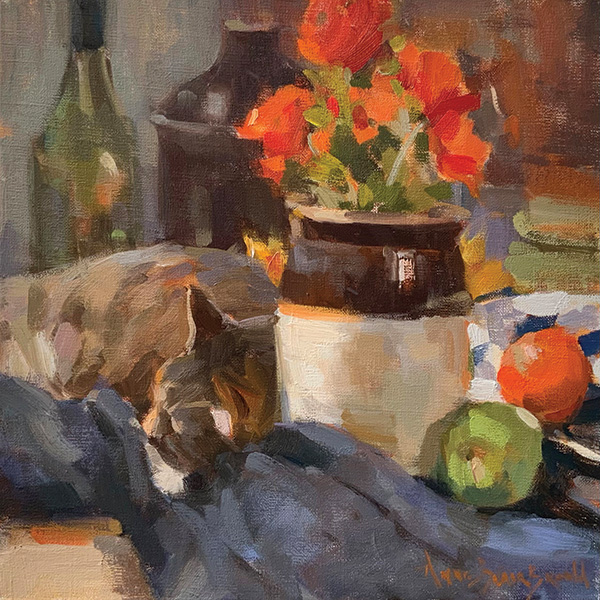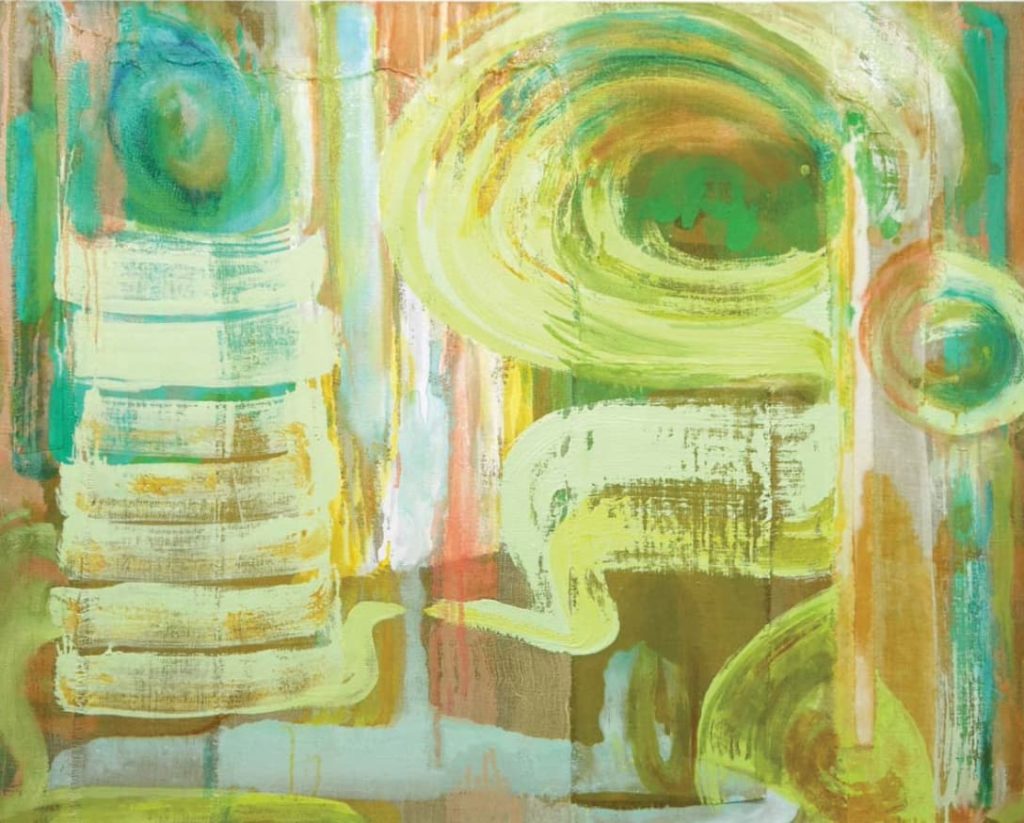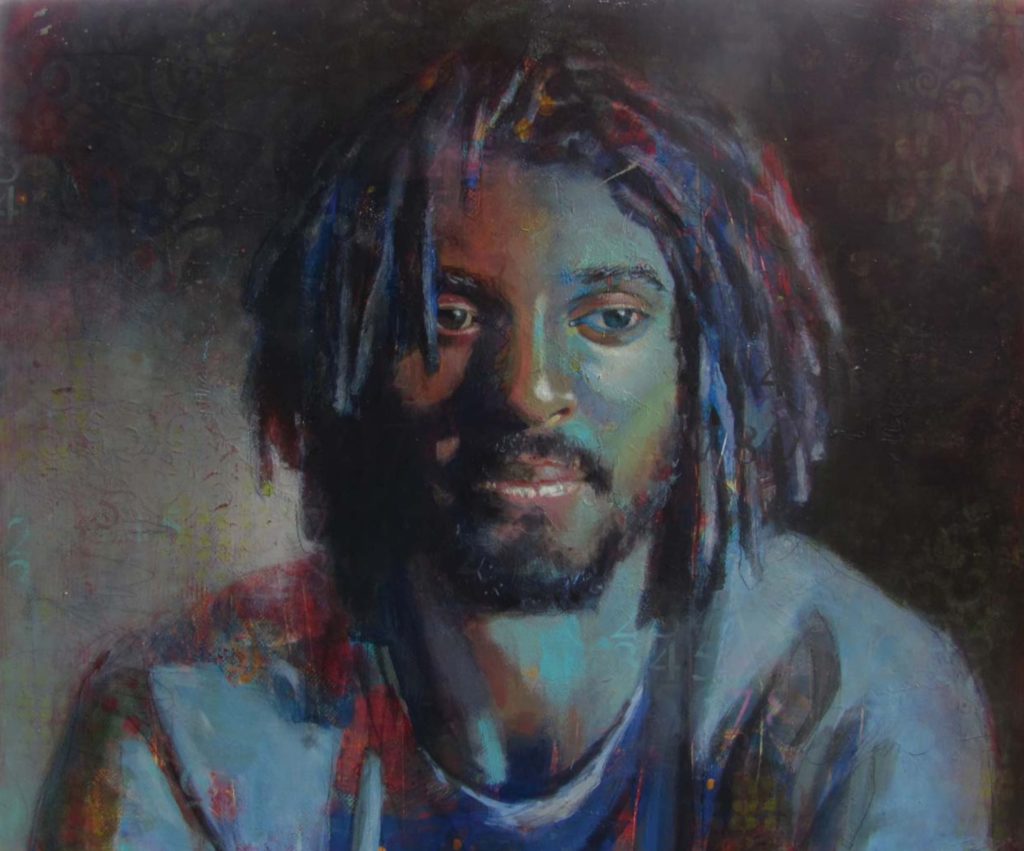Paint Faster by Counting Strokes

Painting Exercises from Anne Blair Brown
This article features excerpts from “Broad Strokes,” by Michael Chesley Johnson, featuring the work of Anne Blair Brown in the October 2022 issue of Artists Magazine.
Anne Blair Brown’s paintings evoke the quiet moments when, for a brief spell, the world pauses its hustle and bustle. A cat snoozing by a crock of flowers, cows in a field with an old shed, sun-drenched Adirondack chairs flanking a small table—each scene is depicted with loose, painterly strokes and restful color harmony. Fittingly, Brown describes herself as a contemporary impressionist. “My work is a modern version of impressionist painting,” she says. “My goal is to give less information with more impact, as was the case for French and Russian Impressionists.”
Tools of the Trade
Anne prefers synthetic or hog bristle Richeson Grey Matters brushes. To help avoid detail, she uses the biggest brushes possible, often starting with a 1- or 2-inch gesso brush to block in the initial tone. Because artist’s brushes can be pricey, she discovered a less expensive option: a 99¢ chip brush from Home Depot. “The chip brushes are nice because they’re kind of frayed, and they make unique marks.” She uses the chip brush for all the big shapes and continues with it until it’s time to start refining the painting. Then she selects from an array of flats, filberts, rounds and egberts, preferring sizes #8, #10 or #12, using the bigger ones for larger canvases.
For her painting support, Anne uses stretched canvas in the studio and rigid panels outdoors, preferring Centurion universally-primed products for both. When making quick studies en plein air, she stays on the small side (8×10 to 12×12) but in the studio enjoys a larger size (16×16 to 30×30) and particularly a square format.

When painting in acrylic, she prefers the Utrecht paints because they are buttery. Her color choices are the same as for her oil palette: Phthalo green, Prussian blue, ultramarine blue, permanent rose, cadmium red light, burnt sienna or burnt umber, cadmium lemon or light yellow, cadmium deep yellow or Indian yellow, yellow ochre, and titanium white.
Learn to Paint Faster with these Painting Exercises!
These two exercises will help you loosen up and paint more decisively, particularly with oils. Note that “one stroke” doesn’t mean one quick mark. The paint you apply before lifting the brush counts as one stroke, which can last several seconds and fill quite a bit of space. Once you lift your brush, make a dot of that color somewhere to help keep count of your strokes.
40-Brush Stroke Painting: Learn to Paint Faster
This exercise will help you paint faster so your work will become more painterly. You’ll see shapes more clearly, make faster decisions and use directional brushstrokes to get varied effects. Do this exercise from direct observation. TIP: A still life will be easiest.
1. Draw several thumbnail boxes (the more the better) and make contour drawings inside them. You can change your compositions or refine an idea. Think only in terms of outlines and shapes, and never lift your pencil from the paper.
2. Observe the values. Use grayscale markers to find four values and then draw notans (black-and-white sketches).
3. Pick your best sketch and use that composition in a tonal underpainting. The color of the tone for the underpainting is up to you. Stain and wipe to get a four-value range. Try not to spend more than 10 to 15 minutes on this. TIP: Don’t use too much thinner.
4 Pre-mix the colors on your palette. For example, if you’re painting an apple, mix the color of the fruit in a light value, then pull some paint from that pool and darken it to make the shadow. Repeat this process with other colors in your composition.
5. Have a painting medium ready, grab some big brushes, and go! TIP: Fill in the largest areas first.
6. Stop after 40 strokes. TIP: Using all sides of your brush will get more paint onto your canvas and create a variety of marks.
7. Giggle hysterically at how much fun that was.

20-10-5 Stroke Exercise: Learn to Paint More Expressively
With this exercise you’ll experience firsthand what it feels like to paint expressively. It will help you understand the hierarchy of what’s important, as you’ll be forced to eliminate detail, train yourself to be decisive and learn not to overwork a painting.
1. Take a 16×20 panel and divide it evenly into quadrants with tape.
2. In the first space, paint a small, timed study to loosen up and familiarize yourself with your subject. Don’t work for more than 30 minutes.
3. In the next space, paint the same subject using only 20 brushstrokes.
4. Paint the same subject in the last two quadrants, using 10 strokes and then 5 strokes.
It doesn’t matter if you end up with a “mess.” Just note how differently your hand and wrist move.
Meet Anne Blair Brown
After learning the fundamentals of painting at the University of Georgia and at Watkins College of Art, Brown embarked on a life of travel and cooking. While employed as a chef, she continued to paint but began to include restaurant interiors and waiters in her work. These paintings proved popular and gained her gallery representation. Before long, a friend suggested she teach. “Teaching has taught me the most about being an artist and has helped me grow in my work,” says Brown. “Having to articulate my process has helped me understand where I want to go.” Brown is the former president of the Plein Air Painters of the Southeast and a Signature Member of the Oil Painters of America and the American Impressionist Society. She’s also active in The Chestnut Group, which her website describes as “a nonprofit group of artists dedicated to preserving endangered ecosystems, historic locales and aesthetically and environmentally significant places.”
Visit Brown’s website at anneblairbrown.com.






Have a technical question?
Contact UsJoin the Conversation!